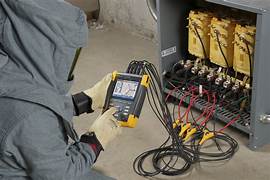Power Quality Optimization
Power quality optimization in a facility setting is crucial for ensuring the efficient and reliable operation of machinery and equipment. Poor power quality can lead to various issues such as equipment malfunction, increased energy costs, and safety hazards.
Common Power Quality Issues:
- Voltage Sags and Swells: Short-duration decreases or increases in voltage levels.
- Harmonics: Non-sinusoidal waveforms caused by non-linear loads like variable frequency drives (VFDs) and rectifiers.
- Transient Overvoltages: Sudden spikes in voltage caused by lightning or switching operations.
- Flicker: Frequent and rapid changes in voltage levels causing noticeable fluctuations in lighting intensity.
- Power Factor Issues: Low power factor due to inductive loads leading to higher energy consumption and costs.
- Interruptions: Complete loss of power for a period, affecting production processes.
Impacts of Poor Power Quality:
- Equipment Damage: Reduced lifespan and increased maintenance costs for machinery and electrical equipment.
- Production Downtime: Interruptions in manufacturing processes leading to financial losses.
- Energy Inefficiency: Higher energy consumption and costs due to poor power factor and harmonics.
- Safety Hazards: Increased risk of electrical fires and accidents.
Mitigation Strategies:
- Power Quality Monitoring: Continuous monitoring using power quality analyzers to detect and diagnose issues.
- Voltage Regulation: Using voltage regulators or uninterruptible power supplies (UPS) to stabilize voltage levels.
- Harmonic Filters: Installing filters to reduce harmonic distortion.
- Power Factor Correction: Using capacitors or synchronous condensers to improve power factor.
- Transient Voltage Surge Suppressors: Protecting equipment from transient overvoltages.
- Proper Grounding and Bonding: Ensuring an effective grounding system to improve overall power quality.
- Maintenance and Upgrades: Regular maintenance of electrical systems and upgrading old or inefficient equipment.
Standards and Guidelines
- IEEE 519: Recommended practices and requirements for harmonic control in electrical power systems.
- IEC 61000: Series of standards dealing with electromagnetic compatibility, including power quality.
- EN 50160: European standard specifying voltage characteristics of electricity supplied by public distribution systems.
Active Dynamic Filtering (ADF) Technology
Technology that makes energy more efficient. Engineered in Sweden, ADF provides a unique way of reducing energy losses in a vast range of applications such as industrial production.
It works by sensing electrical behavior, then reduces energy losses by correcting the electrical behavior. This is achieved by using state-of-the-art signal processing and advanced control structures to manage the power flow to and from the machine with a power processor (power converter). By continuously monitoring the network and injecting exactly the right amount of compensation current—at exactly the right time—the most efficient and accurate solution to any power quality problem can be achieved.

EML with partnership of Comsys AB Sweden, is now providing this technology to its clients. Let us help you with power quality problems.
